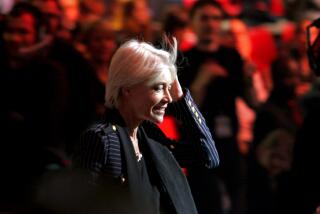Restoration Would Be Music to His Ears : Hardy: St. Michael’s Church will be site of a ‘quire’ gallery as a tribute to old Dorset custom featured in author’s work.
- Share via
STINSFORD, England — For Thomas Hardy’s forebears, worship was enlivened by a merry troupe of musicians and singers who performed Psalms and other sacred pieces set to local tunes.
By the time the writer reached manhood, high church killjoys had abolished these traditional Dorset “quires” and replaced them with organs and somber hymns.
One by one, the musicians’ galleries were pulled down.
Now, thanks to a $104,000 bequest from Richard Little Purdy, a Hardy scholar at Yale University, St. Michael’s Church, where the Hardys worshiped, will be able to rebuild its gallery.
Once again the rafters of this small, squat edifice of gray stone will ring to the sound of violins, cellos, oboes and bassoons--and the lively caroling of singers.
“We hope to rebuild the gallery as close as possible to the original,” said William Jesty, a member of St. Michael’s parochial council. “There are groups which are reviving 19th-Century church music and we hope they will play special occasions and concerts.” Original scores are preserved in the Dorset County Museum in Dorchester.
The bequest also will allow the church to restore a 1930s organ given by Hardy’s sister, Kate.
Hardy learned of the quires from his grandfather, father and uncle--who all played at one time or another in the oak musicians’ gallery at St. Michael’s in Stinsford. A plaque notes that they performed “the office of string players.”
In “Under the Greenwood Tree,” his second published novel, Hardy pays tribute to a vanished tradition with an affectionate portrait of the “Mellstock quire,” a rambunctious troupe of cider-drinking musicians, who entertain worshipers until reform-minded vicar Mr. Maybold decrees that they must go.
“One is inclined to regret the displacement of these ecclesiastical bandsmen by an isolated organist,” Hardy wrote in a preface to the book.
“The change has tended to stultify the professed aims of the clergy, its direct result being to curtail and extinguish the interest of parishioners in church doings.”
St. Michael’s quire was abolished in the 1840s by the church’s vicar, the Rev. Arthur Shirley, a keen supporter of the Oxford Movement and the revival of medieval ritual, who felt the convivial band “distracted from the preaching,” said Jesty. Shirley opted instead for a clockwork barrel organ.
Stinsford’s rotted oak gallery finally came down during restoration work in 1911.
Purdy, a quiet, shy man from a wealthy Boston family, regularly visited Britain in the 1930s and got to know Hardy’s second wife, Florence, who lived on at Max Gate after her husband’s death in 1928.
Between 1978 and 1988, Purdy published seven volumes of Hardy’s letters with Hardy biographer Michael Millgate.
Purdy left a bequest for the upkeep and preservation of St. Michael’s Church, where Hardy’s heart is buried with his two wives, “in affectionate remembrance” of Florence Hardy.
Mrs. Hardy gave Purdy a lot of minor manuscript material, including scrapbooks and source material. He left most of his impressive Hardy collection to Yale, but some items went to the Dorset County Museum in Dorchester.
More to Read
The biggest entertainment stories
Get our big stories about Hollywood, film, television, music, arts, culture and more right in your inbox as soon as they publish.
You may occasionally receive promotional content from the Los Angeles Times.









